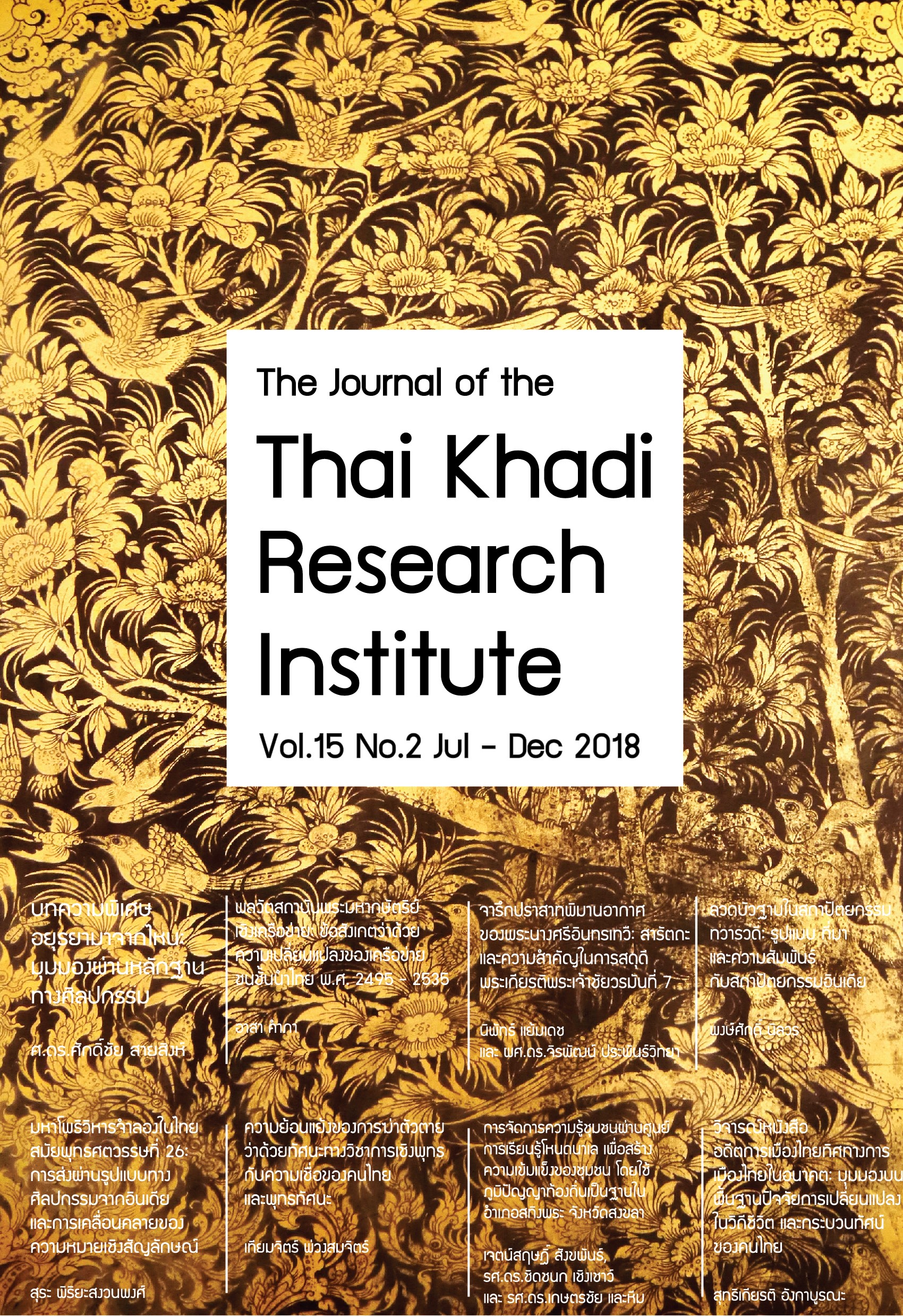Where was Ayutthaya from: Perspective through art evidence?
Main Article Content
Abstract
In Ayutthaya Era, there were a number of art evidence in various forms because Ayutthaya was a big city with people commuting from several cultures. In early Ayutthaya Period, there were Prang Pagodas and Buddha Images in Khmer style, which was the foundation of people from Lopburi. Thus, there is a hypothesis that unless there is any historical documents to show where King U - thong was from, art evidence should be referred to in order to assume that he should have come from Lopburi.
Art evidence, especially pagodas and Buddha images, show that people in Ayutthaya came from various areas because Ayutthaya Kingdom had power and relationships with nearby kingdoms. For instances, Prang pagodas show that there were people from Lopburi; big monasteries at the center of the city were established by kings; pagodas with castle - like top finials and octagonal bell - shaped pagodas, most of which are in the eastern side of the city island and outskirt areas of the city, show the identities of Sukhothai people in Ayutthaya because Sukhothai Kingdom had been merged to Ayutthaya; and Lanna style bell - shaped pagodas and Buddha images reflect that there were Lanna people in Ayutthaya as well, which concurs with historical evidence from middle Ayutthaya period that show that some Lanna people were included in Ayutthaya.
In middle Ayutthaya Era, there were art styles that were original styles of Ayutthaya, i.e., Ayutthaya style bell - shaped pagoda and pagodas with reduced corners, as well as Ayutthaya style Buddha images such as Buddha images with costumes, which reflect the development of craftsmanship that create unique art works that reflect the integration of people from different cultures.
Article Details
There is no charge for paper processing and publication. Once the paper is under peer-review process, however, if the paper is withdrawn for any reason the author will be responsible for the expense of 3,000 Baht occurred in the review process.
References
Chuwichian, P. (2000). Chēdī prathān wat bāng ka čha sathāpattayakam khō̜ng chumchon lānnā nai krung sīyutthayā [Principal Pagoda of Bang Kacha Temple, Lanna Architect in Ayutthaya]. Muang Boran Journal, 26(4), 68 - 75.
Damrong Rajanubhab, Somdekromphraya. (1975). Tamnān phutthačhēdī (Phim khrang thī sām) [Legends of Buddhist Pagodas (3rd ed.)]. Bangkok: Khurusapha.
Ditsakun, S, M.C. (1991). Sinlapa nai prathēt Thai (Phim khrang thī kao) [Arts in Thailand (9th ed.)]. Bangkok: Amarion Printing Group.
Leksukhum, S. (1995). Sinlapaphāknư̄a Riphunchai Lānnā [Northern, Hariphunchai and Lanna Arts]. Bangkok: Ancient City.
_____. (1977). Wiwatthanākān khō̜ng chan pradap lūatlāi læ lūatlāi nai samai ʻAyutthayā tō̜n ton [Evolution of Friezes with Motifs and Motifs in Early Ayutthaya Period]. Bangkok: Amarion Printing.
_____. (1999). Sinlapaʻayutthayā: Ngānchānglūanghǣngphǣndin [Ayutthaya Arts: Royal Crafts of the Kingdom]. Bangkok: Ancient City.
Phrarātchaphongsāwadān krung kao chabap lūang prasœ̄t ʻaksō̜nni [Old City Chronicle by Luang Prasoet - aksonniti]. kham haikān chāo krung kao haikān khunlūang hāwat læ phrarātchaphongsāwadān krung kao chabap lūang thaʻaksō̜nni [Memoire of People from Old City, Memoire of Khun Luang Ha Wat and Old City Chronicle by Luang Prasoet - aksonniti]. (1972). Bangkok: Khang Witthaya Printing House.
Prachum phongsāwadān chabap kānčhanāphisēk lem nưng[Collection of Chronicles for the Golden Jubilee, Volume 1]. Phrarātchaphongsāwadān krung kao chabap lūang prasœ̄t [Old City Chronicle by Luang Prasoet]. (1996). Bangkok: Division of Literature and History, Department of Fine Arts.
Prachum phongsāwadān chabap kānčhanāphisēk lem sām [Collection of Chronicles for the Golden Jubilee, Volume 3]. Phrarātchaphongsāwadān krung sīyutthayā chabap phan čhanthanumāt (čhœ̄m) [Old City Chronicle by Phan Chanthanumat (Chim)]. (1999). Bangkok: Division of Literature and History, Department of Fine Arts.
Saisingha, S. (2007). Sīan thammik rāt čhāk wat thammik rāt khūan mīʻāyu yū nai chūang wēlā dai [What era should Thamikarat Buddha Image Head from Thamikarat Temple be from]. Academic Journal, Faculty of Archaeology, 6(1), 166.
_____. (2013). Phraphuttharūp nai prathēt Thai: rūpbǣp phatthanākān læ satthā khō̜ng Khon Thai [Buddha Images in Thailand: Form, Evolution and Faith of Thai People]. Bangkok: Art History Department, Faculty of Archaeology, Silpakorn University.
_____. (2013). Sinlapa lānnā [Lanna Arts]. Bangkok: Matichon.
_____. (2015). Chēdī nai prathēt Thai: nǣokhit khati kānsāng phatthanākān thāng rūpbǣp læ kān wikhro̜ thāng prawattisāt [Pagodas in Thailand: Concepts, Beliefs for Construction, Development of Forms and Historical Analysis]. Nakhon Pathom: Research and Development Institute, Silpakorn University.
_____. (2017). Chēdī nai prathēt Thai: Rūpbǣp Phatthanākān læphalangsattha [Pagodas in Thailand: Form, Evolution and Faith]. Bangkok: Ancient City.

